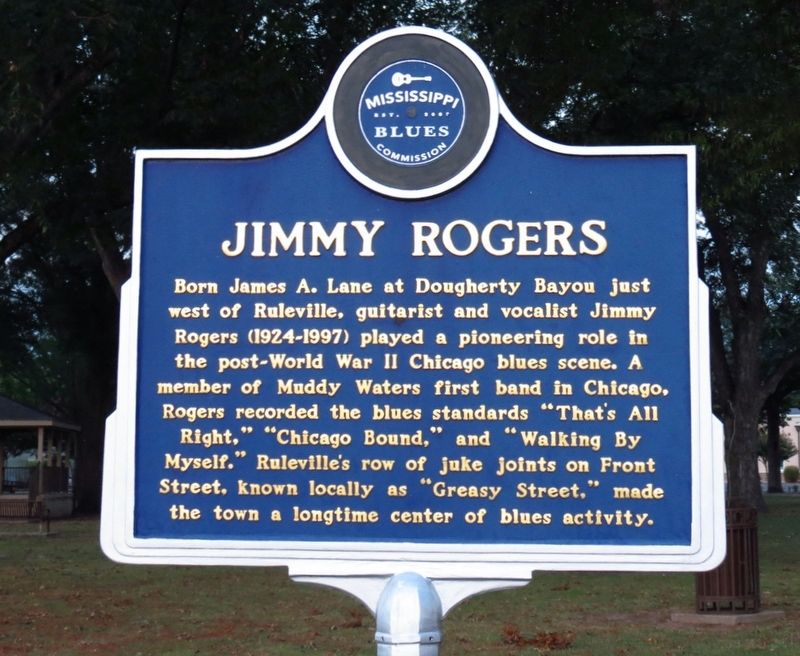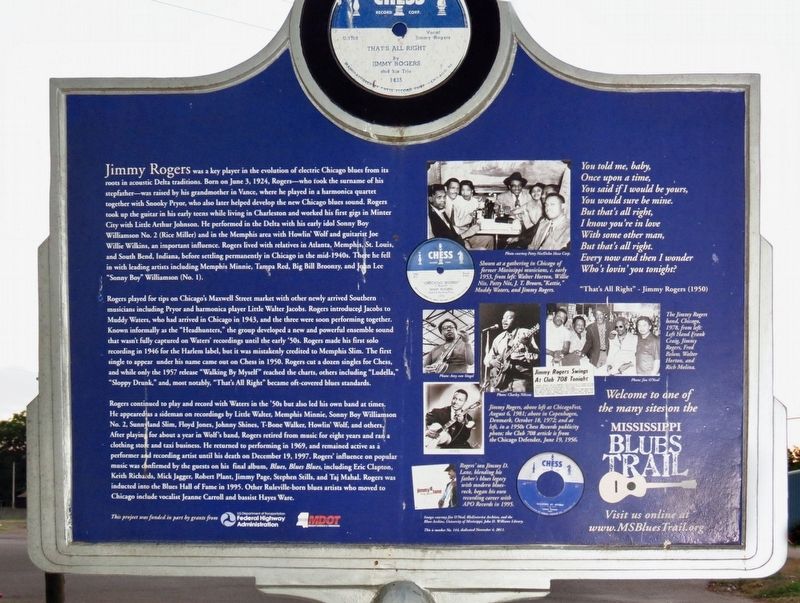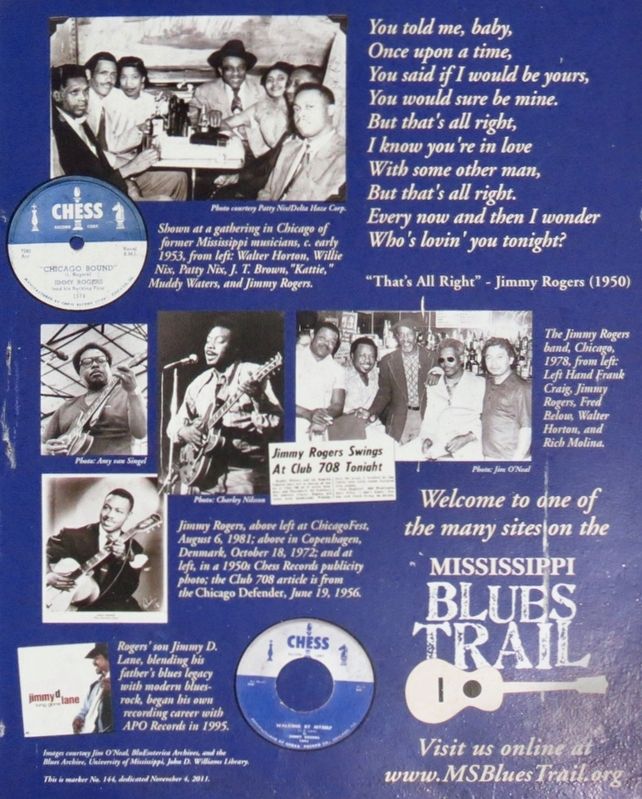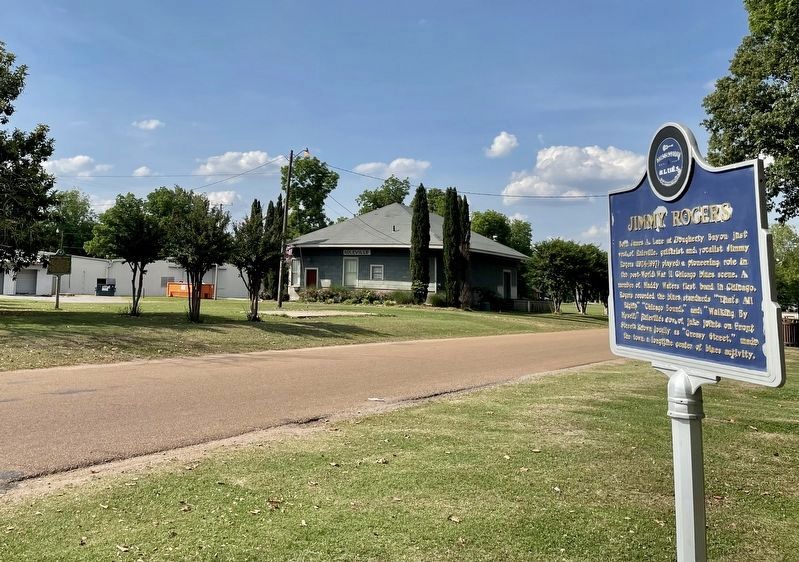Jimmy Rogers
Front
Born James A. Lane at Dougherty Bayou just west of Ruleville, guitarist and vocalist Jimmy Rogers (1924-1997) played a pioneering role in the post-World War II Chicago blues scene. A member of Muddy Waters first band in Chicago, Rogers recorded the blues standards "That's all Right," "Chicago Bound," and "Walking By Myself." Ruleville's row of juke joints on Front Street, known locally as “Greasy Street," made the town a longtime center of blues activity.
Rear
Jimmy Rogers was a key player in the evolution of electric Chicago blues from its roots in acoustic Delta traditions. Born on June 3, 1924, Rogers—who took the surname of his stepfather—was raised by his grandmother in Vance, where he played in a harmonica quartet together with Snooky Pryor, who also later helped develop the new Chicago blues sound. Rogers took up the guitar in his early teens while living in Charleston and worked his first gigs in Minter City with Little Arthur Johnson. He performed in the Delta with his early idol Sonny Boy Williamson No. 2 (Rice Miller) and in the Memphis area with Howlin’ Wolf and guitarist Joe Willie Wilkins, an important influence. Rogers lived with relatives in Atlanta, Memphis, St. Louis, and South Bend, Indiana, before settling permanently in Chicago in the mid-1940s.
Rogers played for tips on Chicago’s Maxwell Street market with other newly arrived Southern musicians including Pryor and harmonica player Little Walter Jacobs. Rogers introduced Jacobs to Muddy Waters, who had arrived in Chicago in 1943, and the three were soon performing together. Known informally as the “Headhunters,” the group developed a new and powerful ensemble sound that wasn’t fully captured on Waters’ recordings until the early ‘50s. Rogers made his first solo recording in 1946 for the Harlem label, but it was mistakenly credited to Memphis Slim. The first single to appear under his name came out on Chess in 1950. Rogers cut a dozen singles for Chess, and while only the 1957 release “Walking By Myself” reached the charts, others including “Ludella,” “Sloppy Drunk,” and, most notably, “That’s All Right” became oft-covered blues standards.
Rogers continued to play and record with Waters in the '50s but also led his own band at times. He appeared as a sideman on recordings by Little Walter, Memphis Minnie, Sonny Boy Williamson No. 2, Sunnyland Slim, Floyd Jones, Johnny Shines, T-Bone Walker, Howlin’ Wolf, and others. After playing for about a year in Wolf’s
band, Rogers retired from music for eight years and ran a clothing store and taxi business. He returned to performing in 1969, and remained active as a performer and recording artist until his death on December 19, 1997. Rogers’ influence on popular music was confirmed by the guests on his final album, Blues, Blues Blues, including Eric Clapton, Keith Richards, Mick Jagger, Robert Plant, Jimmy Page, Stephen Stills, and Taj Mahal. Rogers was inducted into the Blues Hall of Fame in 1995. Other Ruleville-born blues artists who moved to Chicago include vocalist Jeanne Carroll and bassist Hayes Ware.Erected 2011 by Mississippi Blue Commission. (Marker Number 144.)
Topics and series. This historical marker is listed in these topic lists: African Americans • Arts, Letters, Music • Entertainment. In addition, it is included in the Mississippi Blues Trail series list. A significant historical date for this entry is June 3, 1924.
Location. 33° 43.605′ N, 90° 33.155′ W. Marker is in Ruleville, Mississippi, in Sunflower County. Marker is on North Front Street north of West Floyce Street, on the right when traveling north. Located in SW corner of Ruleville Memorial Park. Touch for map. Marker is at or near this postal address: North Front Street, Ruleville MS 38771, United States of America. Touch for directions.
Other nearby markers. At least 8 other markers are within 6 miles of this marker, measured as the crow flies. Ruleville Depot (within shouting distance of this marker); "Greasy Street" (within shouting distance of this marker); William Chapel (approx. 0.6 miles away); Fannie Lou Hamer (approx. 0.8 miles away); a different marker also named Fannie Lou Hamer (approx. 0.9 miles away); Birthplace of the Blues? (approx. 3.7 miles away); Dockery Plantation (approx. 3.7 miles away); Drew, Mississippi (approx. 6 miles away). Touch for a list and map of all markers in Ruleville.
Also see . . . Wikipedia article on Jimmy Rogers. (Submitted on November 19, 2020, by Mark Hilton of Montgomery, Alabama.)
Credits. This page was last revised on May 23, 2021. It was originally submitted on November 19, 2020, by Mark Hilton of Montgomery, Alabama. This page has been viewed 286 times since then and 19 times this year. Photos: 1, 2, 3. submitted on November 19, 2020, by Mark Hilton of Montgomery, Alabama. 4. submitted on May 23, 2021, by Mark Hilton of Montgomery, Alabama.



